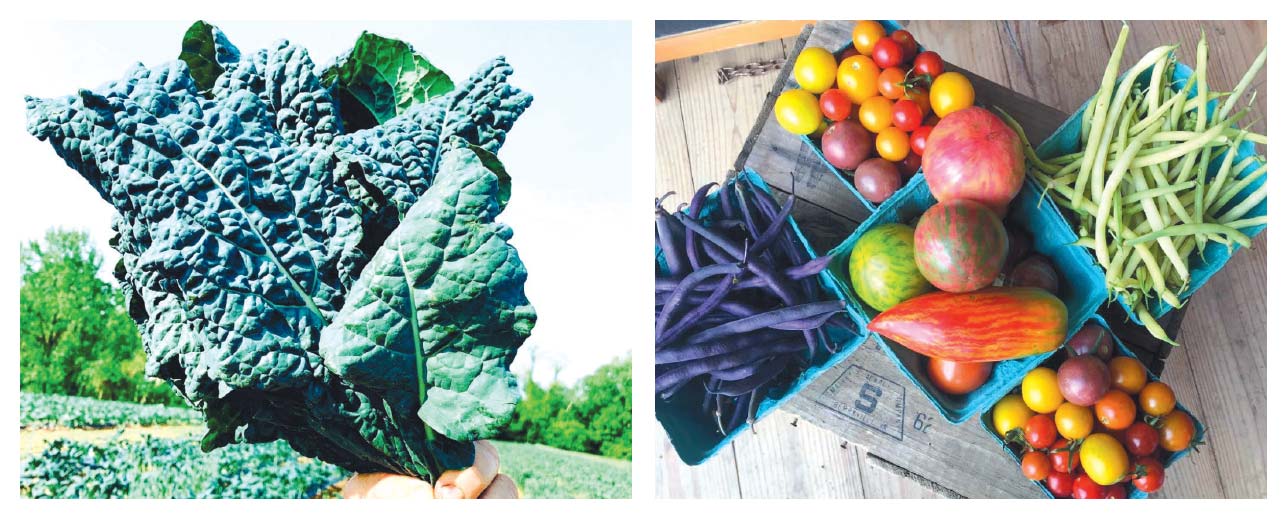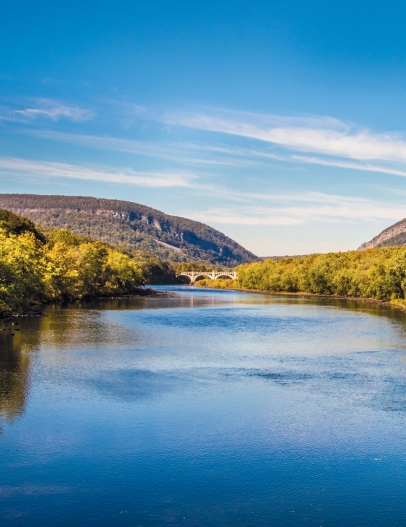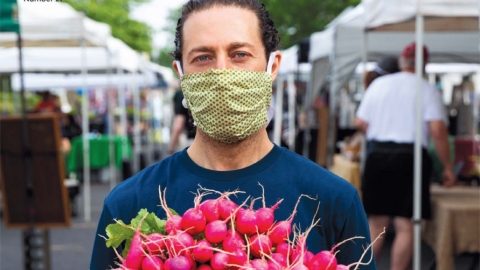Healthy Waters: Safeguarding the Delaware Watershed
AT FIRST GLANCE, the 40-acre farm at the Natural Lands’ Stroud Preserve in Chester County looks like any other farm. Green corn plants stretch towards sun. Hay fields shimmer at dusk. Upon closer inspection, however, it proves to be an unusual growing project.
The preserve is home to a six-year Watershed Impact Trial, a partnership between the Stroud Water Research Center and the Rodale Institute, supported by a $6 million grant from the William Penn Foundation. It investigates farming’s impact on the watershed, from pesticide residue and soil quality to the health of the nearby stream.
There’s reason to track the results. The Delaware River Watershed, our source of drinking water, is influenced by farms upstream—and 20 percent of the land draining into the Delaware is in agriculture, says Chris Kieran, William Penn Foundation senior program associate. Farms play an outsized role in determining the cleanliness of the water in our tap.
WHAT’S IN A WATERSHED?
Philadelphia is part of a vast watershed that spans four states (New York, New Jersey, Pennsylvania and Delaware) and provides drinking water to 13 million people from Manhattan to Center City. A watershed encompasses any land draining into a body of water. “There are about 25,000 miles of streams that run through that land area, all ultimately winding up in the Delaware Bay,” Kieran explains.
Many influences on city water occur elsewhere, including agricultural runoff in farm-focused regions and suburban development, that compromises forests and wetlands. “We have to look upstream and say, ‘Where is pollution coming from, and how do we prevent it at its source?’” says Diana Martin, Rodale’s director of communications and marketing.
Watershed health has improved since the Clean Water Act passed in 1972, says Lamonte Garber, watershed restoration coordinator for Stroud, a leading freshwater science organization. The law addressed point-source pollution—pollution that can be tracked to a single source, such as a factory pipe or drainage ditch—that led to events like the infamous Cuyahoga River fire in 1969. Oily manufacturing debris polluting the river outside of Cleveland ignited a raging inferno on the water that rose five stories high. “We are talking about sewage treatment plants and factories that had pipes literally dumping raw sewage or toxic chemicals directly into streams. Now we’re left with the hard stuff: runoff from the land,” he says.
Within the wider watershed, there are about 14,000 farms. Farm conservation can go a long way towards minimizing pollution. The question is which practices hold the greatest potential.

Top: Natural Lands’ Stroud Preserve Bottom: Streams that were part of the Delaware River Watershed Initiative. Photos courtesy of the Stroud Water Research Center.
FOCUS ON FARMS
The answer starts with science. The Watershed Impact Trial, launched in 2018, investigates the effects of the most common methods of farming in the region: organic farming with tillage (the agitation and turning over of soil to prepare it for growing crops) and reduced or rotational tillage, conventional with tillage and conventional no-till. “There has been a divide, historically, between agriculture and conservation. The William Penn Foundation had the amazing foresight to say: ‘How do we get a group like Rodale that is part of the farming community, and partner them with someone like Stroud that is working in the watershed?’” Martin says. Beyond the trial, Stroud’s watershed restoration group has worked with roughly 150 farms on conservation best management practices since 2014.
In 10-acre plots, the trial examines the relationship between farm and water, tracking everything from crop yields and profits to water infiltration and erosion. “As soon as we cut down forest and turn it into something else—a farm, a parking lot, a coal mine—water quality goes downhill,” Garber says. “We are not going back to that time, so what we are left with is to change how we manage the land.”
Part of the solution may be going organic. Organic farming rules prohibit synthetic pesticides and fertilizers. Yet tillage, which is allowed, can impair soil, potentially amplifying runoff. “If you wanted to imagine what the silver bullet for agriculture would be in terms of a system that was gentlest on the land and clean for the water, it would be 100 percent long-term, no-till organic,” Garber says. “But how do you deal with weed uptakes in that type of a system?”
Rodale continues its work on an organic no-till system. Yet even conventional farms, a majority of those upstream, have a role. As major landholders, their efforts can have a big impact, Garber says, from cover cropping to reduce erosion to fencing off streams to keep animals (and their waste) out of the water.
At the same time, organic certification is only one of a number of moves that can be made to protect the water. “Organic farmers are starting from a position of strength because they are not using these chemicals. Yet they have to do a lot of the same kinds of best practices that conventional farmers do to finish the job.” Cows on organic farms enjoy streambeds as much as cows on any other type of farm.
The hope is that cross-system data from the study will quantify stream impact, enhance conservation modeling and ultimately shape better policy.
A BROAD COALITION
Those results will take time, but work isn’t waiting. Since 2014, the William Penn Foundation has funded the Delaware River Watershed Initiative (DRWI). Focused on forest loss, agricultural runoff and stormwater, the coalition brings together more than 50 organizations working across eight sub-watersheds. In 2018, this added up to nearly $34 million in support.
“We have every different type of farm imaginable,” Kieran says of the region. “On the one hand, when it’s not very centralized, you don’t have the option of making one big move that ricochets throughout the whole system. Yet you can really support local conservation organizations that know their area, know their place and know their farmers.”
One area with a heavy agricultural footprint is the Middle Schuylkill Cluster. There, DRWI member Berks Nature helps its largely Mennonite farming community implement conservation best management practices. “We started diving into agricultural restoration for water quality 15 years ago,” says Tami Jo Shimp, VP of development and community relations. Today, she sees growing demand. DRWI funding has escalated the group’s ability to reach farms, make the case to farmers that investment in conservation practices is beneficial—especially to a Mennonite population resistant to accepting government funding—and cluster work among a number of farms for greater impact.
Partnering with the Natural Resource Conservation Service, the farms take a whole-farm approach, examining factors including gutter installation, liquid manure storage, stream fencing, and riparian buffers to keep cattle on land and a percentage of pollutants out of streams.
Importantly, plans take farmers’ needs into account. “We want farms to be successful,” Shimp says. For example, investing in a liquid manure storage unit not only keeps waste out of the water, it also improves farm operations by offering a consolidated approach to waste management.
Since 2003, the Schuylkill Action Network has united 150 organizations under a similar mission. Initiated by the Philadelphia Water Department, SAN focuses on the 40 percent of Philadelphia drinking water that is sourced from the Schuylkill. “They recognized that they needed to invest upstream,” says manager Virginia Vassalotti. Among seven working groups, agriculture has been very successful. “Now we know how to better manage farms, and there are practices that not only help the farm to become more productive, but also help water quality.”
In nearby Lancaster County, that’s a conversation Casey Spacht of Lancaster Farm Fresh has often with his 100-plus Amish and Mennonite organic farm members. Before a farmer can join the co-op, a rigorous onboarding process digs into on-farm practices. “Our farmers are organic, so they don’t use any harmful chemicals or synthetic pesticides. It’s the things that we don’t do that are saving our farms,” he says. That’s a matter of principle: Once chemicals are applied, it’s impossible to limit them to one area or keep them from finding their way to a stream.
Instead, the farmers focus on planting water-filtering crops and building up the soil, which holds water better and stays together during rainfall. “Often, we stand in the way,” Spacht says. His goal is to help farmers work with the land to have an overall positive effect. “We can grow the best veggies on this part of the farm, but on this other part of the farm, let’s make more forest.”
Even a single farm can have an impact. In Downingtown, Two Gander Farm grows certified organic fruits, vegetables, flowers and herbs on acreage rented from the Brandywine Conservancy. Serving 200 CSA members, two local grocery chains and the Bryn Mawr farmers’ market, the farm is part of a network of 64,000 acres permanently preserved by the Brandywine Conservancy. Deirdre Flemming, who grows with husband Trey, says that value alignment makes the partnership work.
“One of their major focus areas is watershed protection,” Flemming says. As a former Stroud intern with a passion for aquatic biology, that’s a mission she shares. Long before she farmed, Stroud exposed her to the deep connection between water and agriculture. In that spirit, the Flemmings have implemented water-friendly measures on their farm, many tied to their organic certification. “It’s rotating crops and making sure you’re not depleting the soil,” she says.
Flemming cautions that irresponsibility can happen in the organic community, too. For example, even organic compost can be overapplied, or applied on a slope that heads towards the water. Progress requires a nuanced view. “This is something I tell my customers,” she says. “You really have to make sure that it all checks out.”

Left: Lancaster Farm Fresh. Photo courtesy of Lancaster Farm Fresh. Right: Two Gander Farm. Photo courtesy of Two Gander Farm.
THE EATER’S ROLE
Flemming partnered with Rodale on a new campaign designed to help urbanites make the farm-to-water connection. Its premise is simple: What we eat plays a big role in the quality of our drinking water.
At GrowCleanWater.org, launched in December, families learn about the connection between healthy farms and healthy water and pledge to support water-friendly practices—among them supporting organic farmers who protect the water, and learning how to grow herbs and vegetables at home. By the spring, 1,000 families pledged, Martin says, claiming the entire run of pledge kits, which included organic seeds, a magnet promoting Philly farmers’ markets and more. A children’s book and virtual reality experience is set to launch this summer to replace the initial kit. “Bringing kids and families into the conversation is a really important part of fixing our food system.”
Educational events are also planned, though they have been moved to 2021. In the meantime, people can meet farmers like Flemming online. “They’re starting to make the connection that they live in our community, we farm in our community and we’re taking care of the natural resources that affect them,” Flemming says.
It’s an interesting opportunity for Philadelphians to think about food from a different angle, Kieran says. “It’s really great for Philadelphians to understand this concept of upstream and downstream, and the way that agriculture shows up in the health of the streams that run through the city.”
Delaware River Watershed by the Numbers
4 states
(PA, DE, NJ, NY)
13,500
square miles
14,000
farms
15,000
miles of streams & rivers
HELP THE WATERSHED @ HOME
- Visit GrowCleanWater.org.
- Plant a tree or install a rain barrel.
- Grow compost for your farmer.
- Green your neighborhood, from planting to trash pick-up.
- Ask your farmer about their water-friendly practices.
- Visit a nature preserve in the watershed.
- Explore your conservation district at pacd.org.
LEARN MORE
- William Penn Foundation: williampennfoundation.org
- Delaware River Watershed Initiative: 4states1source.org
- Schuylkill Action Network: schuylkillwaters.org
- Stroud Water Research Center: stroudcenter.org
- Rodale Institute: rodaleinstitute.org
- Berks Nature: berksnature.org
- Brandywine Conservancy: brandywine.org/conservancy






